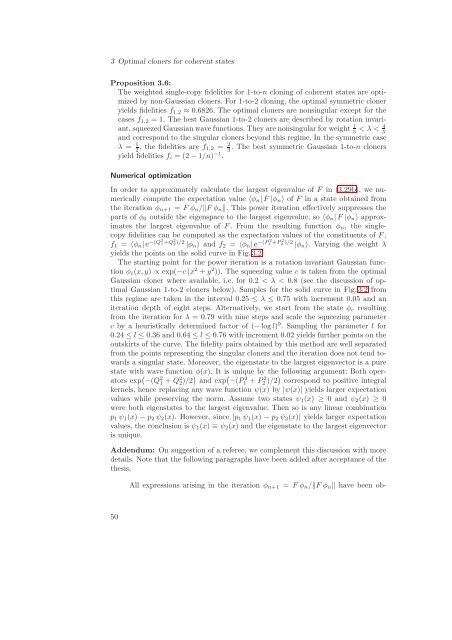Quantum Information Theory with Gaussian Systems
Quantum Information Theory with Gaussian Systems
Quantum Information Theory with Gaussian Systems
You also want an ePaper? Increase the reach of your titles
YUMPU automatically turns print PDFs into web optimized ePapers that Google loves.
3 Optimal cloners for coherent states<br />
Proposition 3.6:<br />
The weighted single-copy fidelities for 1-to-n cloning of coherent states are optimized<br />
by non-<strong>Gaussian</strong> cloners. For 1-to-2 cloning, the optimal symmetric cloner<br />
yields fidelities f1,2 ≈ 0.6826. The optimal cloners are nonsingular except for the<br />
cases f1,2 = 1. The best <strong>Gaussian</strong> 1-to-2 cloners are described by rotation invariant,<br />
squeezed <strong>Gaussian</strong> wave functions. They are nonsingular for weight 1<br />
5<br />
and correspond to the singular cloners beyond this regime. In the symmetric case<br />
λ = 1<br />
. The best symmetric <strong>Gaussian</strong> 1-to-n cloners<br />
2 , the fidelities are f1,2 = 2<br />
3<br />
yield fidelities fi = (2 − 1/n) −1 .<br />
Numerical optimization<br />
< λ < 4<br />
5<br />
In order to approximately calculate the largest eigenvalue of F in (3.29b), we numerically<br />
compute the expectation value 〈φn| F |φn〉 of F in a state obtained from<br />
the iteration φn+1 = F φn/F φn. This power iteration effectively suppresses the<br />
parts of φ0 outside the eigenspace to the largest eigenvalue, so 〈φn| F |φn〉 approximates<br />
the largest eigenvalue of F. From the resulting function φn, the singlecopy<br />
fidelities can be computed as the expectation values of the constituents of F,<br />
f1 = 〈φn| e −(Q2 1 +Q2 2 )/2 |φn〉 and f2 = 〈φn| e −(P2 1 +P2 2 )/2 |φn〉. Varying the weight λ<br />
yields the points on the solid curve in Fig. 3.2.<br />
The starting point for the power iteration is a rotation invariant <strong>Gaussian</strong> function<br />
φc(x, y) ∝ exp(−c (x 2 + y 2 )). The squeezing value c is taken from the optimal<br />
<strong>Gaussian</strong> cloner where available, i.e. for 0.2 < λ < 0.8 (see the discussion of optimal<br />
<strong>Gaussian</strong> 1-to-2 cloners below). Samples for the solid curve in Fig. 3.2 from<br />
this regime are taken in the interval 0.25 ≤ λ ≤ 0.75 <strong>with</strong> increment 0.05 and an<br />
iteration depth of eight steps. Alternatively, we start from the state φc resulting<br />
from the iteration for λ = 0.79 <strong>with</strong> nine steps and scale the squeezing parameter<br />
c by a heuristically determined factor of (− log l) 9 . Sampling the parameter l for<br />
0.24 ≤ l ≤ 0.36 and 0.64 ≤ l ≤ 0.76 <strong>with</strong> increment 0.02 yields further points on the<br />
outskirts of the curve. The fidelity pairs obtained by this method are well separated<br />
from the points representing the singular cloners and the iteration does not tend towards<br />
a singular state. Moreover, the eigenstate to the largest eigenvector is a pure<br />
state <strong>with</strong> wave function φ(x). It is unique by the following argument: Both operators<br />
exp −(Q 2 1 + Q 2 2)/2 and exp −(P 2 1 + P 2 2 )/2 correspond to positive integral<br />
kernels, hence replacing any wave function ψ(x) by |ψ(x)| yields larger expectation<br />
values while preserving the norm. Assume two states ψ1(x) ≥ 0 and ψ2(x) ≥ 0<br />
were both eigenstates to the largest eigenvalue. Then so is any linear combination<br />
p1 ψ1(x) − p2 ψ2(x). However, since |p1 ψ1(x) − p2 ψ2(x)| yields larger expectation<br />
values, the conclusion is ψ1(x) ≡ ψ2(x) and the eigenstate to the largest eigenvector<br />
is unique.<br />
Addendum: On suggestion of a referee, we complement this discussion <strong>with</strong> more<br />
details. Note that the following paragraphs have been added after acceptance of the<br />
thesis.<br />
50<br />
All expressions arising in the iteration φn+1 = F φn/F φn have been ob-
















